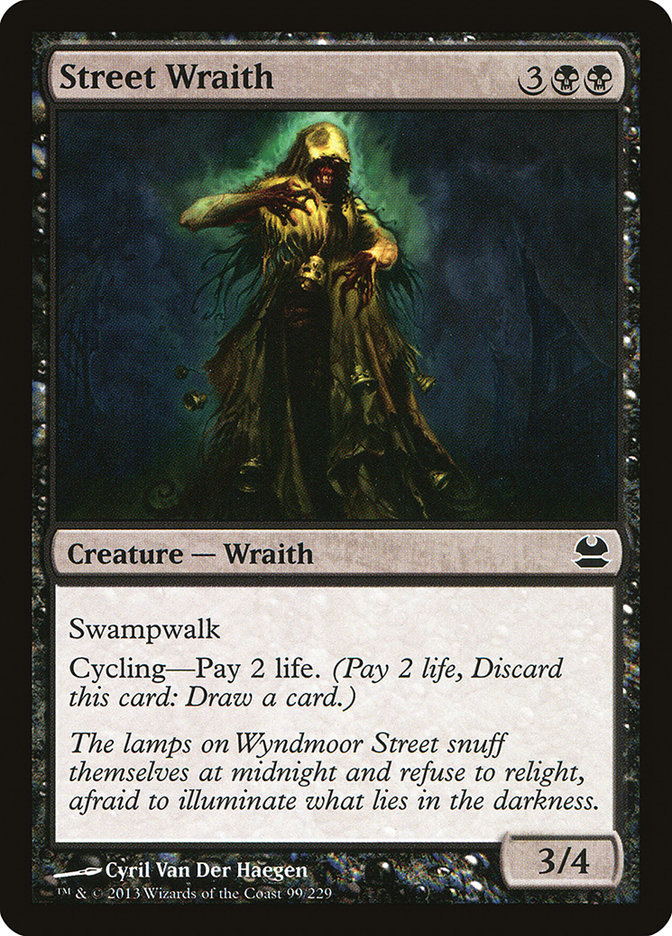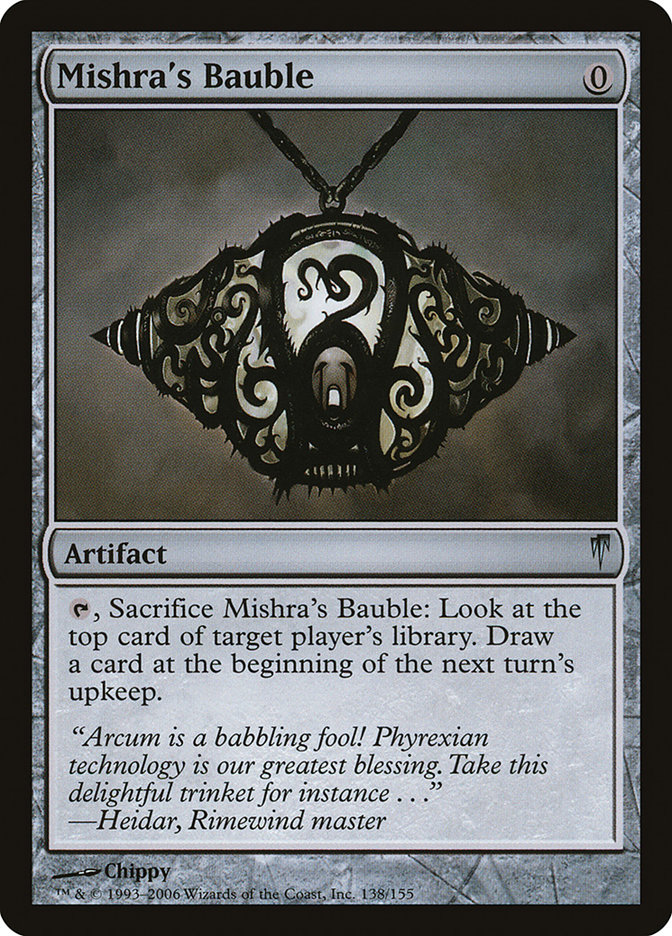I’ve been playing a ton with Death’s Shadow.
A lot of that is because I just started streaming, but it also has to do with the fact that exploring Death’s Shadow has opened up a new archetype in Modern, one that I find truly enjoyable to play, as you are functionally playing Legacy against your opponent.
Your deck is full of cheap spells that all produce interactive games. There is a huge tension every game as you aggressively manage your life total as a resource. In some matchups in particular this can make for some really exciting Magic – Burn certainly comes to mind.
Death’s Shadow is also just an amazingly powerful Magic card, one that strikes me as having the potential for being too good. As I’ve phrased it across a few different mediums – now that the hive mind has collectively “figured out” that you can play Death’s Shadow in several different “fair” cores – the Death’s Shadow archetype itself is incredibly malleable.
This ability to customize your deck by such a wide margin takes huge leaps towards fixing pre-existing problems in older midrange archetypes like Jund and Grixis.
Jund doesn’t have to constantly force itself into positions of playing long games against every deck and hoping to topdeck them.
I’m no longer afraid to play against Tron or Burn with Grixis, and those concerns about not being able to close out games are long gone.
The Core
The only cards you truly “have to play” are a simple black core:
These three cards, paired with approximately twelve fetchlands, are enough enablers for Death’s Shadow to be your premier threat. It is more efficient and ends games more quickly than any other creature in Modern.
Of course, you’re likely interested in playing Fatal Push and some number of Inquisition of Kozilek, but the point is that the opportunity cost for registering Death’s Shadow is actually much lower than one might expect.
Breaking It Down
As of this writing I have played in tournaments either in real life or on Magic Online with four versions of Death’s Shadow.
A common question I receive is, “Is X version better than Jund?” The answer is not simple.
Jund is “the best” because it is the most-tuned version of the deck and has been played the most by the community. It has had several tournament results over the past month and a half, putting it far out in front of various blue versions. That said, Grixis has started to put up Magic Online results by several players over the past few weeks, and I suspect that the other versions will begin to do so as well once folks figure out how to build their decks in the way they desire.
I’m going to share all of my current lists, discuss some of their respective strengths and weaknesses, and then talk a bit about general sequencing and gameplay.
Creatures (12)
Planeswalkers (2)
Lands (18)
Spells (28)

This is how I would currently build Jund Shadow and my goal is largely just about making it as no-nonsense as possible.
A lot of folks probably view Ghor-Clan Rampager as a sacred cow, but I disagree. Sure, there are games where you draw Traverse the Ulvenwald and a Rampager can represent lethal damage, but a lot of the time, you are interested in sideboarding out some copies of Traverse, and Rampager is by far the weakest card in the deck.
Battle Rage does a much better job at effectively closing games and racing combo decks, which is the key difference between Jund and various blue versions. Counterspells like Stubborn Denial actually check the top of your opponent’s deck. As a result, it is largely unnecessary to have any effect like Temur Battle Rage, of which the primary goal is essentially to chop a turn off the clock.
As a result, Jund is great at deploying pressure quickly and consistently through Traverse the Ulvenwald, but it plays worse the longer a game goes on, and it is particularly vulnerable to combo decks that are seeking to utilize Leyline of Sanctity.
Due to the fact that it is hyper-focused on playing efficient games in the first turns, Jund is also slightly behind in any kind of mirror match. The necessity of cards like Tarfire to enable delirium as quickly as possible makes it so they largely have dead cards against opposing Shadow decks. Further, the lack of super-powerful bombs like Snapcaster Mage means that they tend to have weaker top decks in general.
This factor is also a bit of a weakness against any midrange deck simply looking to try to kill all of your stuff, like Abzan.
I won’t necessarily argue that the blue versions have great matchups against decks positioned in this manner, but it certainly is much closer.
I’m not exactly sure if these types of decks are prevalent enough to justify splashing, perhaps just for Ranger of Eos and a few copies of Path to Exile, so for now I would just register straight-up Jund.
Creatures (16)
Lands (19)
Spells (25)

First of all, I think Delver of Secrets sucks, and playing Death’s Shadow without Street Wraith is basically just nonsense. Delver is remarkably unreliable in Modern and nudges your deck towards being more interested in countermagic because you need to protect your threat against the top of your opponent’s deck for a longer period of time.
Chipping your opponent for upwards of six damage may not even be particularly relevant in many situations, as you are likely going to take control and clock them in two turns with a Death’s Shadow after clearing the way for it.
Further, Delver also just provides a relevant target for interaction that just isn’t particularly good against you, like Lightning Bolt.
As I’ve already alluded to, Grixis is very good at playing long games because Kolaghan’s Command and Snapcaster Mage are so powerful. Further, Stubborn Denial is a massive inclusion that provides significantly more game against big mana decks and various forms of combo.
My biggest question mark regarding building the deck is actually the inclusion of Lightning Bolt. Clearly it is a great card, but it wouldn’t be crazy for me to think that I’ll ultimately come to the conclusion that a few copies of Terminate deserve the spots in the maindeck more. For now, the fact that Lightning Bolt gives you more insulation against planeswalkers like Liliana of the Veil and its ability to help turn on your Death’s Shadows give it the nod for now, but I certainly wouldn’t feel bad about cutting Lightning Bolt from this deck if I wanted to pair it with Burn in Team Unified Modern.
I should also note that a subtle change is rather important. Playing the second Blood Crypt over the second Steam Vents is far better for early sequencing purposes.
Creatures (15)
Planeswalkers (2)
Lands (18)
Spells (25)

Admittedly, Sultai Shadow is the version of Death’s Shadow that I’ve thought about and played the least with, but I did 5-0 a League on its initial draft.
Essentially, Sultai is the best Stubborn Denial deck and an exceptional Liliana of the Veil deck. Tarmogoyf makes turning on the former trivial, and the aggressive squeeze Sultai can put an opponent in when playing Stubborn Denial makes it very difficult for opponents to get out from under Liliana.
The largest weakness of Sultai is its lack of cheap interaction. You are heavily reliant on Fatal Push and some matchups are simply going to be difficult when you don’t draw it.
From my first iteration, I’ve largely increased the threat density with the inclusion of Tasigur, the Golden Fang. Snapcaster Mage is a fine role player in this deck and a solid target for Traverse, but that aspect of this strategy is far less prevalent than in Jund.
Sultai is great against combo, but weaker against aggressive decks and mirror matches.
Creatures (16)
Lands (19)
Spells (25)

Esper, in theory, should be the version of Shadow with the highest ceiling, but it also is likely the hardest deck to build correctly. Having access to a ton of “hard” removal like Path to Exile and Orzhov Charm means that you should be well-positioned in mirror matches and against any other creature deck including Bant Eldrazi.
Further, white sideboard cards are objectively the most powerful in Modern, even if it is impossible to utilize Rest in Peace in this strategy.
The biggest nod against this deck is losing Kolaghan’s Command. That is a huge cost when we are a heavy Snapcaster deck, but Orzhov Charm does pull some similar weight – even enabling some back-door scenarios of Thought Scour milling your own Death’s Shadow.
General Sequencing
Simply, if you need additional land, then cycle Street Wraith before cracking a fetchland. I’m typically comfortable always cycling post-fetch if I have a second land, but this can change based on your hand.
If I already have an ideal first turn lined up, like a discard spell or removing my opponent’s first threat, then I tend to hold Street Wraith to gauge how the next turn cycle plays out. This can be further compounded in complexity by Mishra’s Bauble.
I will almost always cycle in scenarios where I have three to four lands lined up and a small cushion of life. I’m not arguing that you should never cast Street Wraith, but always be aware of the fact that the ceiling on a draw step is so much higher than a 3/4.
If I have fetchland plus discard spell, then I Bauble my opponent first.
In almost every other situation I tend to Bauble myself if I have a fetchland. The ability to improve your draws has a vastly higher ceiling than gaining a little bit more information in most scenarios.
Pray that your Mishra’s Bauble doesn’t crash Magic Online.
Death’s Shadow is essentially always the aggressor in the matchup, which means that sitting back on Snapcaster Mage when close to parity is almost always wrong.
Efficiency is the absolute key to playing these decks, and sinking your mana on various turns can quickly lead to disaster, as typically your bottleneck is going to be mana and not cards.
As a result, I almost always jam Snapcaster Mage on Serum Visions or a discard spell when the battlefield is at parity. Building your position and generating velocity is just so much more important than looking for spots to do “more powerful things.”
About the only exception is leaving up Snapcaster Mage on Stubborn Denial when you are clocking your opponent.
Life Totals
Generally, you should be courageous with your life total in the majority of situations. Of course, you should be expecting to turn on Death’s Shadow quickly, and as a result be shocking yourself, casting Thoughtseizes, and cycling Street Wraiths liberally.
Typically you can quickly gauge how the games are going to play out with discard spells to see if you should begin slowing down, but I’m never really worried until the range of seven to eight life, as you begin to enter “Bolt-Snap-Bolt” territory and the potential for your Thoughtseizes and Wraiths to get turned off.
That said, there are certainly matchups and games, particularly those where you are set up to quickly Tarmogoyf or Tasigur your opponent, where you can potentially play more like a normal interactive deck and ride these threats.
The Future of Death’s Shadow
We are in a really exciting exploration phase in Modern, one that may ultimately end in Death’s Shadow being deemed too powerful. In the meantime, however, I’m interested in being one of the people that pushes the archetype into that territory.
Death’s Shadow makes for some unintuitive games that are legitimately fun to play. The fact that you can customize your deck to your liking means that I’m really enjoying Modern these days and I highly recommend that everyone pick up a version that appeals to them.








